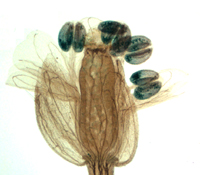
Successful Trap of a Pollen-Specific GeneIdentifying genes based on patterns of gene expression in specific organs or at specific stages of development is a useful approach to improving our understanding of complex biological processes. Scientists Vivian Irish at Yale University in Connecticut, Rob Martienssen at Cold Spring Harbor Laboratory in New York, and their colleagues used a strategy known as "gene trapping" to identify numerous genes involved in the regulation of flower development in the model plant Arabidopsis thaliana.
The research is reported in a paper by Nakayama et al. in the September issue of The Plant Cell. The gene trap technique involves genetic transformation of Arabidopsis plants with a reporter gene whose activity is visualized in a simple assay, leading to the rapid identification of genes that show specific patterns of expression. In this case, the researchers isolated 80 different gene trap Arabidopsis lines identifying genes that show distinct patterns of expression in flower petals and/or stamens (the pollen-bearing organs). The research is one of the first large-scale gene trap studies in the area of flower development, and provides extensive information on many genes likely to have critical roles in this essential stage of plant reproduction.
Genes provide the blueprints for proteins that carry out the functions of living cells. In any particular organ or tissue at any particular stage of development, gene activity may be "on" (expressing the messenger RNA transcripts that lead to production of the corresponding protein) or "off" (no expression). Examining gene expression patterns therefore provides information on gene function. Gene trapping is an alternative to methods such as DNA microarray analysis for the detection of differentially expressed genes, and has the advantage of identifying subtle differences in expression patterns within target organs. For example, genes expressed only in stamen tissue during the early stages of pollen development are likely to have an important function in controlling pollen formation.
The gene trap technique used by Drs. Irish and Martienssen involved genetic transformation of Arabidopsis plants with the reporter gene ß-glucuronidase (GUS) lacking an external promoter sequence to drive gene expression. Each transformation event leads to insertion of the GUS gene at a random site within the plant genome. All endogenous genes contain promoter sequences that determine where and when they will be expressed in an organism. The reporter GUS gene, lacking its own promoter, will only be expressed and produce the GUS protein if it happens to be inserted into the plant genome in the immediate vicinity of an endogenous gene promoter. GUS activity is assayed in transformed plants by treating harvested seedlings with a stain that turns blue in the presence of GUS. Successful "gene trapped" plants will show the characteristic blue stain in specific patterns in the organs or tissues of interest. The endogenous gene corresponding to the trapped promoter can be fished out of the genome and sequenced based on its proximity to the inserted reporter gene. Further experiments can then be conducted, for example, to examine the expression of the native gene in wild type plants and to investigate gene function by creating mutant plants that either lack expression of or overproduce the native protein.
As noted by Dr. Martienssen "gene traps are powerful tools to examine both gene expression and gene function in animal and plant systems. Large scale studies like this are going to provide valuable information concerning regulatory networks and target genes". Dr. Irish added "using the gene trapping strategy, we have identified a host of new genes involved in floral development, as well as illuminating some of the processes involved in establishing different tissues and organs. This general approach is very effective in providing novel insights into development that are not easily gleaned using other available techniques."
Many of the trapped genes were sequenced and identified, giving clues about how they might function in petal and stamen development. Floral organ development depends on appropriate specification and differentiation of the unique organ identities (e.g. petals, stamens, ovules). An interesting aspect of this research is the finding that the expression of many trapped genes is restricted to particular subdomains of the proximodistal axis of petals and stamens, implying that intensive regulation of patterning along this axis is critical for floral organ development.
This research, conducted with grant support from the National Science Foundation, is an excellent example of how modern molecular biology techniques help to increase our understanding of complex biological processes.
Source : American Society of Plant Biologists
 Print Article
Print Article Mail to a Friend
Mail to a Friend
